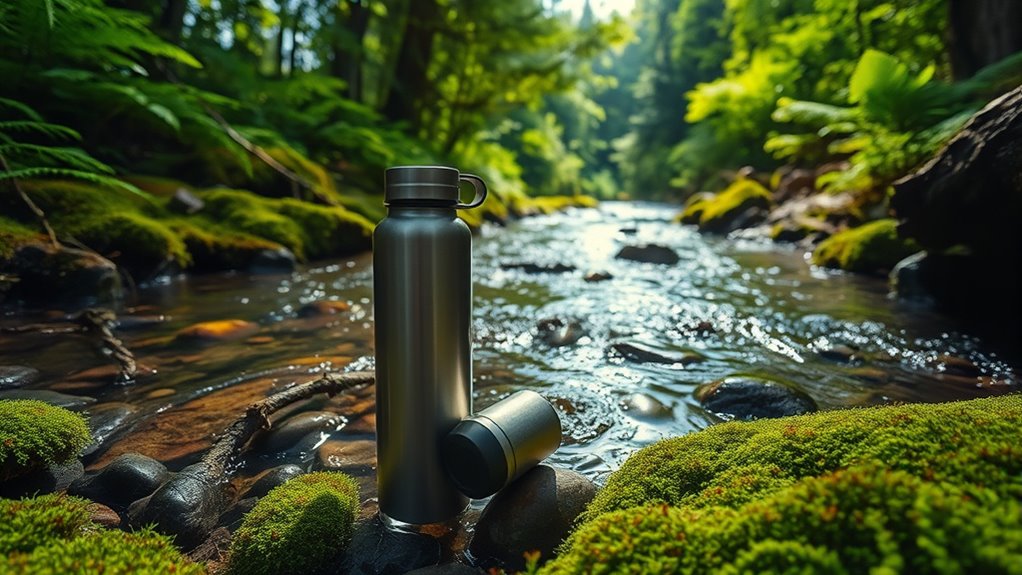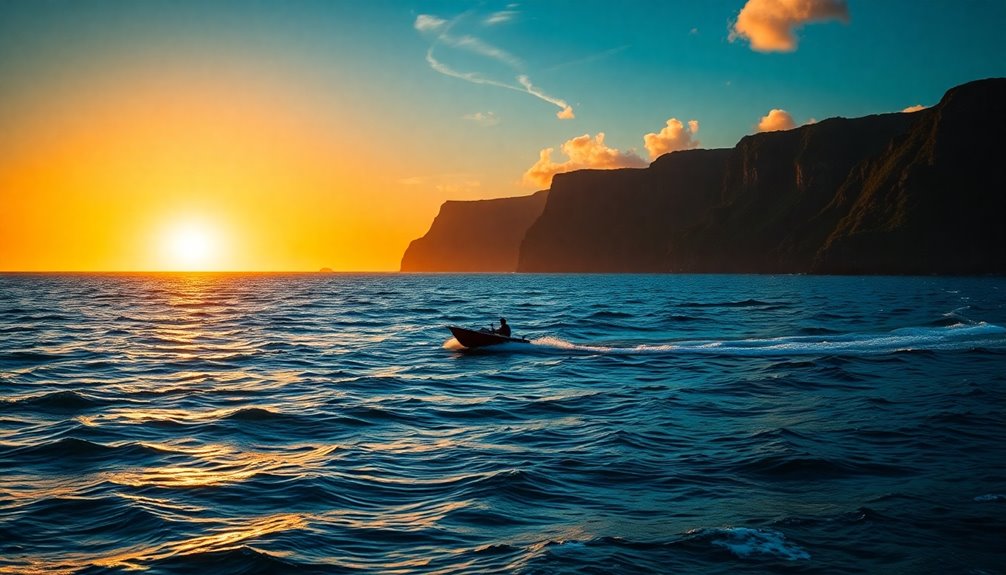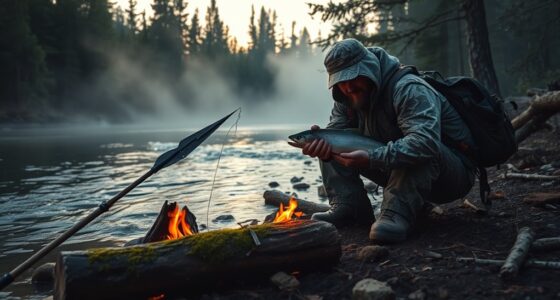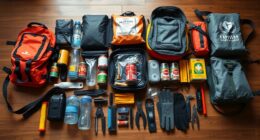In the wilderness, safe water purification is vital for survival. You can boil water for at least one minute, or use chemical treatments like iodine or chlorine tablets to kill harmful pathogens. UV light purifiers are effective, too, but make sure to pre-filter murky water. Reliable filtration systems can remove impurities, but keep in mind that not all methods eliminate heavy metals. Understanding these methods can help you stay safe and hydrated in any situation. Keep exploring for more tips!
Key Takeaways
- Boil water for at least one minute at sea level to kill most pathogens; increase time at high altitudes.
- Use chemical treatments like iodine or chlorine tablets for lightweight and effective purification on backpacking trips.
- Employ UV light purifiers, ensuring water is pre-filtered to enhance effectiveness and following manufacturer guidelines.
- Invest in reliable water filtration systems that effectively remove pathogens but may not eliminate heavy metals; maintain regularly.
- Always carry multiple purification methods and familiarize yourself with local water sources before wilderness excursions.
Understanding the Importance of Water Purification
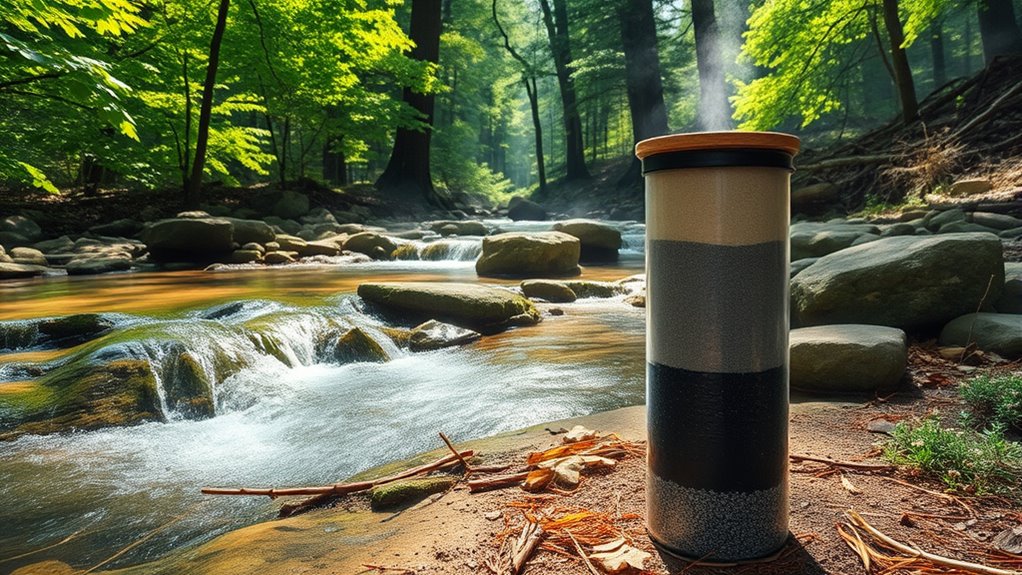
When you consider the risks of drinking contaminated water, it's clear why purifying water is essential for your health. Consuming unpurified water can expose you to harmful pathogens like bacteria, viruses, and protozoa, leading to serious illnesses such as giardia and dysentery.
These waterborne diseases can have immediate and long-term health effects, making it crucial to prioritize clean water access, especially in wilderness settings where dehydration can strike quickly. By purifying water, you take an important preventive step to protect yourself during outdoor adventures.
Always remember that sources like stagnant water are more likely to be contaminated, so knowing how to identify and purify water is vital for your safety and well-being.
Methods of Boiling Water for Safety
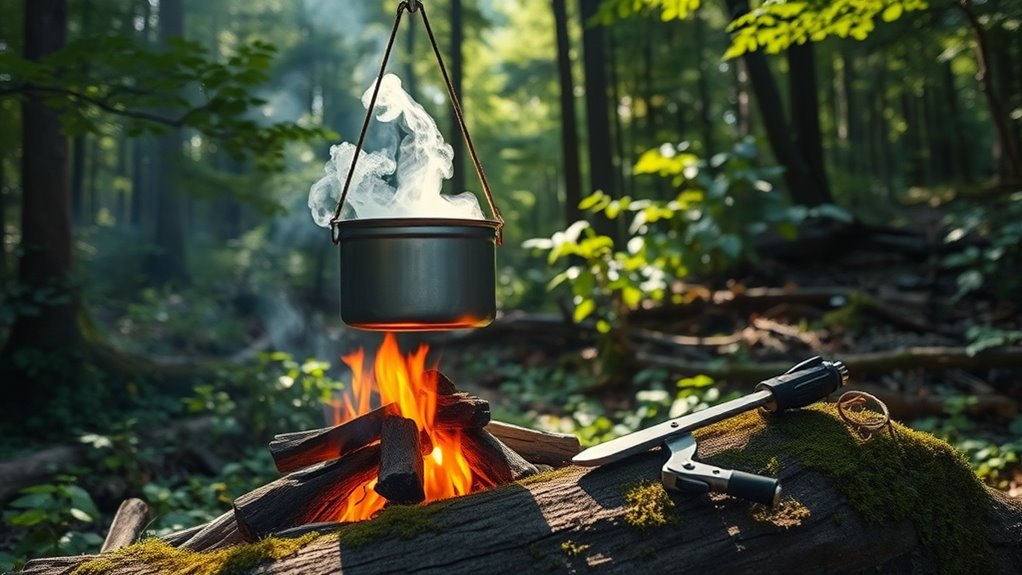
Purifying water through boiling is one of the most effective methods to ensure safety during outdoor adventures. To boil water, you'll need a heat source and a container. The most common method involves using a fire and a heat-resistant vessel.
If you're in a pinch, try the hot rock method—just heat rocks and place them in a makeshift container. At high altitudes, remember that water boils at a lower temperature, so increase your boiling time to three minutes above 6,500 feet.
Consider alternative containers like wooden bowls, bamboo, or even birchbark. Always boil water for at least one minute at sea level to kill most pathogens, ensuring you've got safe drinking water.
Chemical Treatments: Pros and Cons

Chemical treatments offer a practical solution for safely purifying water, especially in situations where convenience is key.
Lightweight and easy to carry, iodine and chlorine make great companions for backpacking trips. They're simple to use and require minimal equipment, effectively killing bacteria, viruses, and some protozoa.
However, keep in mind that they mightn't eliminate all chemical contaminants. The cost-effectiveness and wide availability of these treatments enhance their appeal, as they can make water safe to drink in just 30-45 minutes.
On the downside, chemically treated water often has an unpleasant taste and may pose health risks if overused. Plus, improper disposal can harm aquatic life, so always handle chemicals carefully and store them properly.
Utilizing UV Light Purifiers Effectively
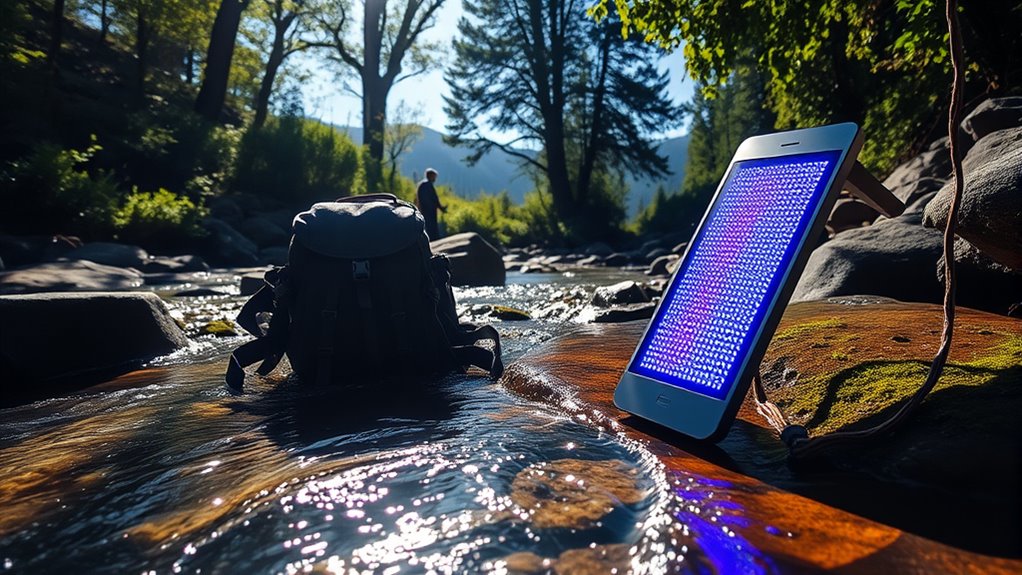
How can you make the most of UV light purifiers for safe water?
First, always inspect your device before use to ensure it's in good working condition, and make sure the batteries are charged.
Since UV purifiers work best with clear water, pre-filter to remove any particulates that might block the light.
Pre-filter your water to eliminate particulates, ensuring optimal performance of your UV purifier.
Be mindful of water conditions; turbidity and cloudiness can reduce effectiveness.
Follow the manufacturer's guidelines for treatment times, typically just seconds to minutes.
If possible, have backup purification methods ready in case your UV device fails.
Lastly, familiarize yourself with your purifier's limitations, especially regarding pathogens like Cryptosporidium and Giardia, to ensure safe drinking water in the wilderness.
Water Filtration Systems: What You Need to Know
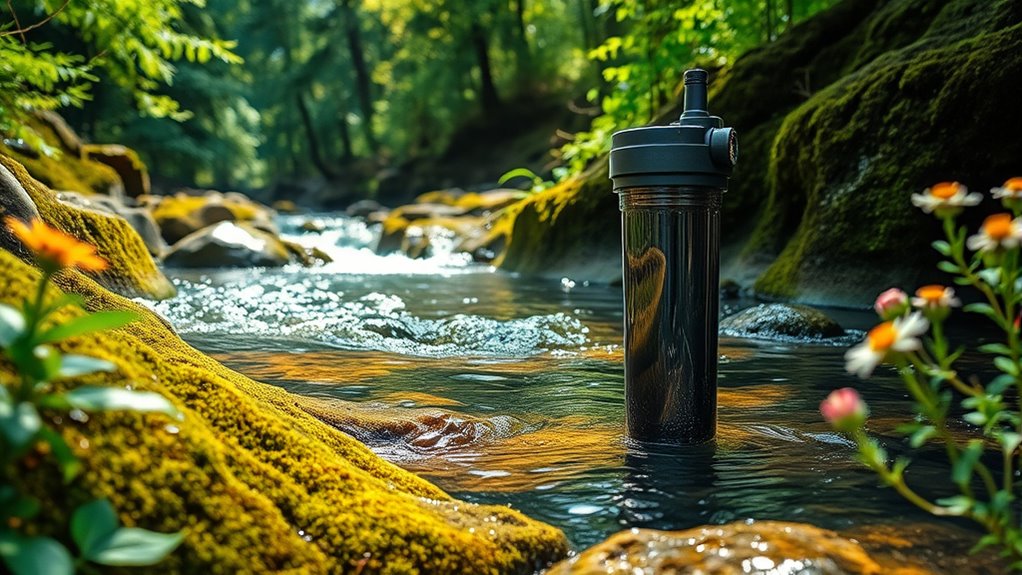
When you're out in the wilderness, having a reliable water filtration system can make all the difference in ensuring safe drinking water. Common options include gravity-fed systems, portable filters, and survival filters, each designed for different needs.
These systems effectively remove bacteria, viruses, and protozoa, but they mightn't eliminate all chemical contaminants or heavy metals. Most are lightweight and easy to carry, perfect for backpackers and hunters.
Remember, regular maintenance is crucial—filters require cleaning or replacement to stay effective. Prices vary significantly, so choose one that fits your budget and durability needs.
Investing in a good water filtration system can keep you hydrated and healthy during your outdoor adventures.
Distillation: A Comprehensive Approach
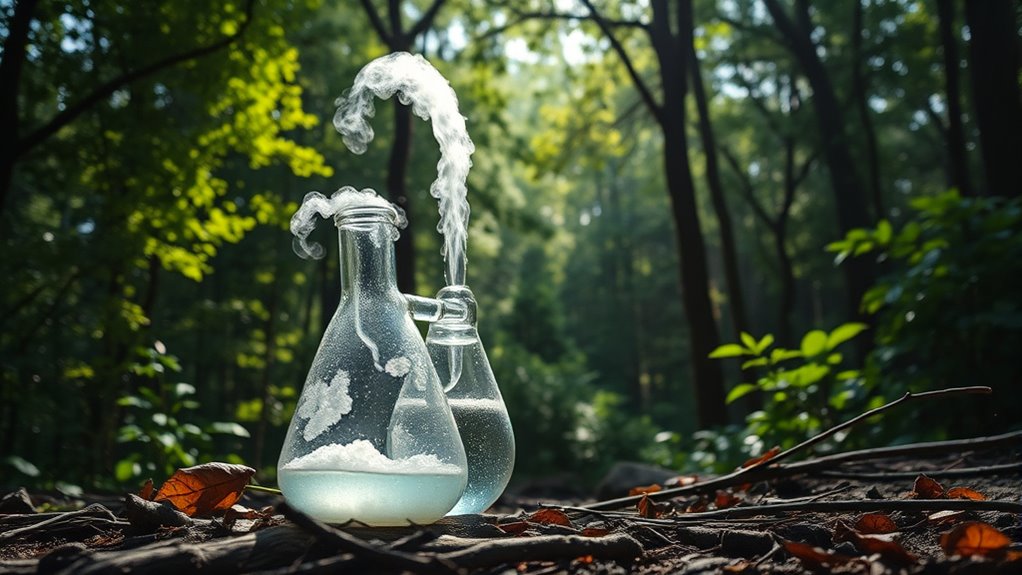
While water filtration systems are great for removing many contaminants, they may not be sufficient for all situations.
Distillation offers a robust method for purifying water by boiling it to produce vapor, which then condenses back into liquid, leaving impurities behind. This technique effectively removes dissolved chemicals, heavy metals, and pathogens that boiling alone can't eliminate.
You can utilize makeshift methods like a solar still or the pot and lid method to distill water in the wild. However, be aware that distillation can be time-consuming and requires a reliable heat source.
Always discard the first steam collected, as it may contain volatile contaminants. Mastering distillation is invaluable in wilderness survival and emergency scenarios.
Identifying Reliable Water Sources in the Wilderness
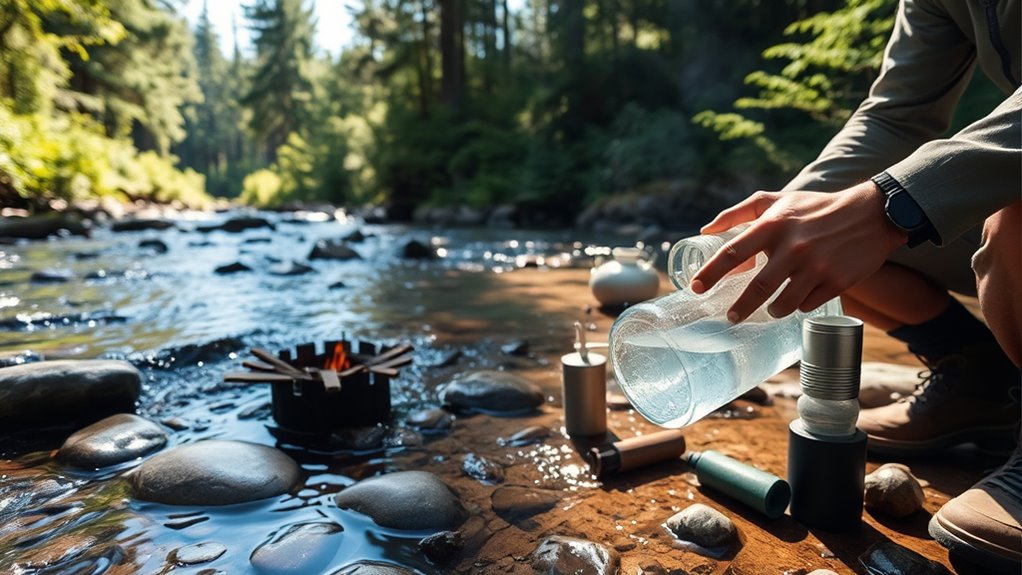
Where can you find reliable water sources in the wilderness?
Look for rivers and streams, as they often provide a steady supply of flowing water, which is generally safer than stagnant options.
Lakes can also be reliable, but their quality varies, so be cautious.
Springs are excellent sources, typically offering clear water straight from the ground.
Keep an eye on vegetation; lush greenery often signals nearby water.
Following animal tracks can lead you to reliable sources since wildlife frequently seeks water.
Additionally, collect rainwater or morning dew when possible.
In arid areas, digging a few feet into the ground might reveal underground water.
Always assess the water's clarity and flow before using it.
Preparing Water for Purification
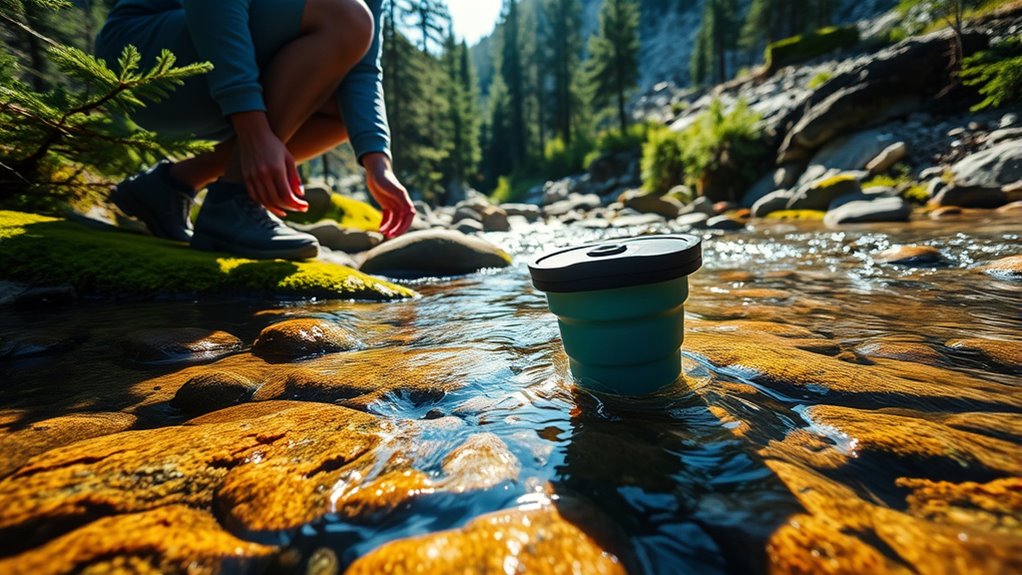
Before purifying water, it's essential to prepare it properly to ensure your methods are effective. Start by selecting the clearest water source available, as this will aid in the gross filtration process.
You can create a simple filter using materials like sand, rocks, moss, or even a T-shirt. Construct a cone-like container, such as a plastic bottle, to hold these materials. This pre-filtering step helps prevent clogging in finer filters and enhances overall efficiency.
Once you've filtered out larger particles, you can move on to more advanced purification methods. Remember, the better you prepare the water initially, the more effective your purification efforts will be.
Exploring Natural Purification Techniques
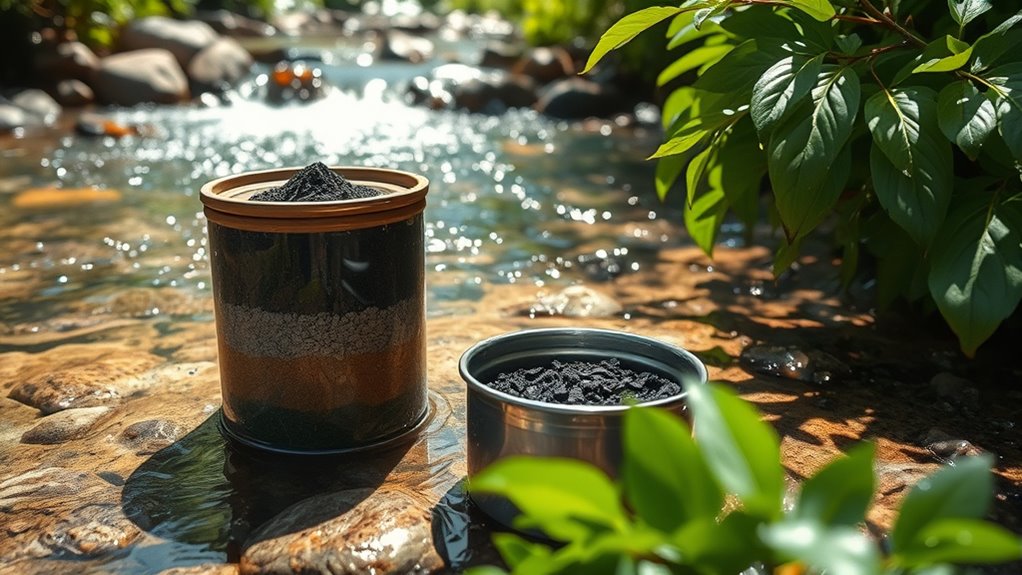
When you're in a survival situation or simply looking for alternative ways to purify water, exploring natural purification techniques can be invaluable.
You can start with sand and rock filtration to remove larger particles, or use a cloth, like a T-shirt, for sediment filtration. For enhanced filtration, add moss or charcoal.
Primitive soil filtration involves digging near a water source to collect cleaner water. Conifer wood can even help eliminate bacteria.
Don't forget about boiling—it's the most reliable method to kill pathogens. If you're in a bind, solar stills and transpiration bags can effectively collect purified water.
Essential Portable Purification Tools for Survival

In survival situations, having the right portable purification tools can mean the difference between health and illness.
You should consider the Sawyer Products SP128 Mini Water Filtration System for its lightweight design, perfect for backpacking. The LifeStraw Personal Water Filter is another excellent choice, removing 99.999% of bacteria and weighing less than two ounces.
For quick filtration, the MSR TrailShot offers a convenient pump-style design. If you're facing extreme conditions, the Survivor Filter PRO features a robust three-stage system.
Lastly, the Katadyn Vario Water Filter is renowned for its durability across various environments.
These tools ensure you can access safe drinking water, enhancing your chances of survival in any wilderness scenario.
Frequently Asked Questions
How Can I Tell if Water Is Safe to Drink?
To tell if water is safe to drink, look for signs of contamination.
If it has an unusual taste or odor, or appears cloudy or discolored, it's best to avoid it.
Check for microbial indicators like E. coli, which can suggest harmful bacteria.
You can also use home testing kits to detect specific contaminants.
When in doubt, purify the water using boiling or filtration methods before drinking to ensure it's safe.
What Are the Signs of Waterborne Illnesses?
You mightn't realize it, but that refreshing sip could lead to unexpected symptoms.
If you experience diarrhea, abdominal cramps, or vomiting, your water source might be contaminated.
Skin rashes and eye irritation could also signal trouble.
Don't ignore respiratory issues like coughing or difficulty breathing—they could stem from waterborne pathogens.
Stay vigilant about any of these signs, especially if you've recently consumed water from questionable sources.
Your health depends on it!
How Long Can I Store Purified Water?
You can store purified water for up to two years if you keep it sealed in food-grade containers.
Make sure to store it in a cool, dark place to prevent bacterial growth.
If you're using tap water, it's best to replace it every six months to a year.
Remember to regularly check your containers for damage and rotate your stock to ensure your water remains fresh and safe to drink.
Can I Purify Seawater for Drinking?
You can't just gulp down seawater and expect to survive; it's like drinking liquid poison!
To purify seawater for drinking, you need specialized techniques like distillation or reverse osmosis. These methods can separate the salt from the water, making it safe.
But remember, it's not a quick fix. You'll need the right tools and patience.
Always be cautious; drinking untreated seawater can lead to severe dehydration and other health issues.
What Should I Do if I Have No Purification Tools?
If you don't have purification tools, you can still make water safer to drink.
Start by boiling it for at least a minute to kill most pathogens. If that's not possible, use sunlight; fill a clear container and leave it in direct sunlight for several hours.
You can also improvise a primitive filter using sand, gravel, and cloth to remove larger particles.
Always choose moving water sources and avoid visibly contaminated ones.
Conclusion
In the wild, staying hydrated is crucial for survival, and knowing how to purify water can make all the difference. Did you know that nearly 2 billion people lack access to safe drinking water worldwide? By mastering purification techniques like boiling, using chemical treatments, or employing filtration systems, you can ensure your water is safe. Always be prepared and carry essential tools to safeguard your health—your life may depend on it! Stay safe, stay hydrated!

